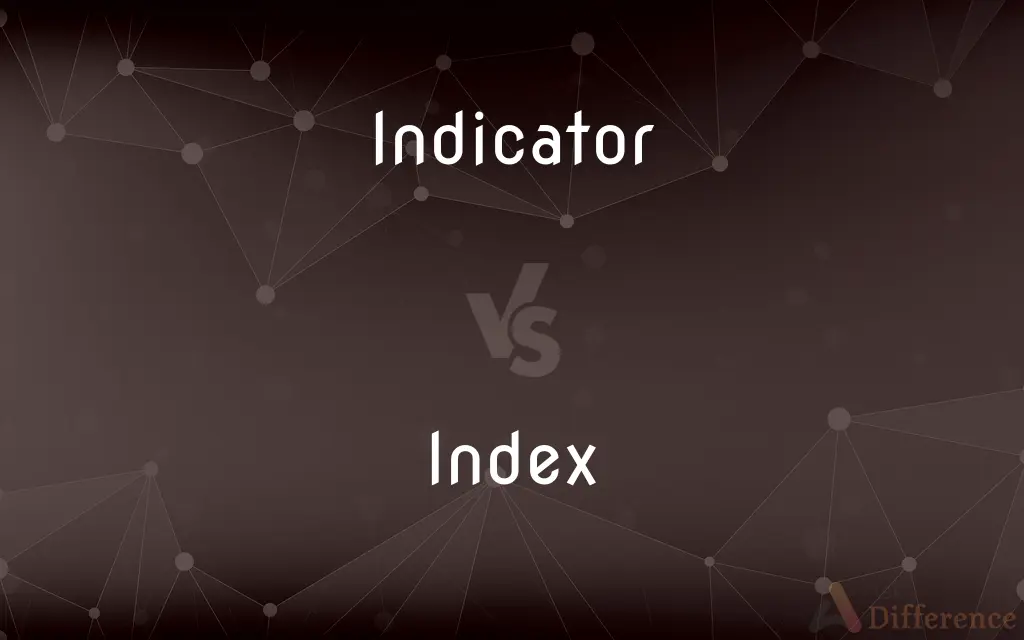Indicator vs. Index — What's the Difference?
Edited by Tayyaba Rehman — By Fiza Rafique — Updated on February 24, 2024
An indicator is a measurable variable used to demonstrate trends or changes in conditions, while an index aggregates multiple indicators to provide a comprehensive overview of a particular aspect, like economic health.

Difference Between Indicator and Index
Table of Contents
ADVERTISEMENT
Key Differences
Indicators are individual data points or measurements that signal the state or trend of a specific condition or phenomenon, such as inflation rates indicating economic stability. They are singular measurements that can highlight specific aspects of a broader situation, allowing for targeted analysis and decision-making. Indexes, by contrast, compile multiple indicators into a single composite score or value, like the Consumer Price Index (CPI), offering a more holistic view of complex conditions, such as overall economic health or market trends, facilitating broader assessments and comparisons.
The utility of an indicator lies in its specificity, enabling detailed insights into particular areas of interest, such as employment rates for labor market analysis. This specificity can guide targeted policy interventions or business strategies. Indexes, however, provide a synthesized view, combining various indicators to reduce complexity and present an easily understandable measure of broader phenomena, aiding in general decision-making and public understanding.
Indicators often serve as the building blocks for indexes, with their individual trends and changes informing the composite measure. The relationship between them is integral, as the selection of relevant indicators directly influences the accuracy and relevance of an index. This interplay ensures that indexes reflect comprehensive and nuanced understandings of the phenomena they measure.
The development and use of indicators require precise definition and consistent measurement methodologies to ensure reliability and validity. Indexes, meanwhile, additionally involve complex statistical methods to aggregate and sometimes weight individual indicators, requiring careful consideration to ensure they accurately represent the phenomena of interest.
Indicators are widely used in research, policy development, and specific sector analysis, providing essential data points for in-depth studies. Indexes find broad application in economic planning, investment analysis, and public communication, offering accessible summaries of complex data sets for a wide audience, including policymakers, investors, and the general public.
ADVERTISEMENT
Comparison Chart
Definition
A measurable variable that signals the state or trend of a specific condition.
A composite measure aggregating multiple indicators to provide an overview of a broader condition.
Purpose
Offers detailed insights into specific areas of interest.
Provides a synthesized view of complex conditions through a composite score.
Composition
Singular data point or measurement.
Compilation of multiple indicators into a single value or score.
Application
Used for targeted analysis in research and policy development.
Utilized for general decision-making and public communication.
Complexity
Less complex, focused on specific phenomena.
More complex, involving aggregation and sometimes weighting of various indicators.
Compare with Definitions
Indicator
Air quality index values serve as indicators of environmental health.
Higher air quality index values indicate poorer air quality.
Index
The S&P 500 is a stock market index that measures the stock performance of 500 large companies listed on stock exchanges in the United States.
The S&P 500 is often used as a benchmark for the overall market.
Indicator
A pointer or index that indicates something.
Index
To adjust (wages, prices, taxes, etc.) automatically so as to compensate for changes in prices, usually as measured by the consumer price index or other economic measure. Its purpose is usually to copensate for inflation.
Indicator
Graduation rates are indicators of educational attainment.
Higher graduation rates suggest better educational outcomes.
Index
To enter in an index.
Indicator
Inflation rate is an indicator of economic stability.
Central banks monitor inflation rates to adjust monetary policies.
Index
To adjust through indexation.
Indicator
A thing that indicates the state or level of something
Car ownership is frequently used as an indicator of affluence
Index
To normalise in order to account for inflation; to correct for inflation by linking to a price index in order to maintain real levels.
Indicator
Any of various statistical values that together provide an indication of the condition or direction of the economy.
Index
To be indexical for (some situation or state of affairs); to indicate.
Indicator
(economics) A measure, such as unemployment rate, which can be used to predict economic trends.
Index
Adjust through indexation;
The government indexes wages and prices
Indicator
Stock market volume is an indicator of market activity.
Increased trading volume can indicate higher investor interest in the market.
Index
The Consumer Price Index (CPI) measures the average change over time in the prices paid by urban consumers for a market basket of consumer goods and services.
The CPI rose by 2% last year, indicating inflation.
Indicator
The unemployment rate is an indicator of labor market health.
A rising unemployment rate indicates weakening labor market conditions.
Index
The Dow Jones Industrial Average is an index that shows how 30 large, publicly-owned companies based in the United States have traded during a standard trading session in the stock market.
The Dow Jones Industrial Average dropping signals investor pessimism.
Index
The Human Development Index (HDI) combines indicators of life expectancy, education level, and income to assess countries' social and economic development.
Countries with higher HDI scores are considered to have better living conditions.
Index
The Global Peace Index aggregates various indicators to measure the relative position of nations' and regions' peacefulness.
A lower Global Peace Index score indicates a more peaceful country.
Index
An alphabetized list of names, places, and subjects treated in a printed work, giving the page or pages on which each item is mentioned.
Common Curiosities
What is an indicator?
An indicator is a measurable variable that reflects the state or trend of a specific condition, offering detailed insights into particular areas of interest.
How do indexes help in public communication?
Indexes simplify complex data, making it accessible and understandable to a broad audience, facilitating public discourse and understanding.
What is an index?
An index is a composite measure that aggregates multiple indicators to provide an overview of a broader condition, simplifying complex data sets for easier understanding.
Why are indexes important in economic analysis?
Indexes provide a comprehensive overview of economic conditions, simplifying complex information for policymakers, investors, and the public, aiding in decision-making and analysis.
Can an indicator be used on its own?
Yes, indicators can be used independently for targeted analysis or research, providing specific insights into particular conditions or trends.
How do indicators and indexes differ in their purpose?
Indicators provide specific insights into particular phenomena, while indexes offer a synthesized view of complex conditions by combining multiple indicators.
How is an indicator chosen for inclusion in an index?
Indicators are chosen based on their relevance, reliability, and ability to reflect changes in the condition or phenomenon the index measures.
Can an index include multiple types of indicators?
Yes, an index can include various types of indicators, each reflecting different facets of the condition or phenomenon it aims to measure.
Do all indexes weigh their indicators equally?
No, some indexes weight indicators differently, reflecting their relative importance or impact on the overall measure.
What role do indicators play in policy development?
Indicators provide essential data that inform policy decisions, allowing for targeted interventions in specific sectors or conditions.
Share Your Discovery

Previous Comparison
Pudding vs. Cake
Next Comparison
Overemphasise vs. OveremphasizeAuthor Spotlight
Written by
Fiza RafiqueFiza Rafique is a skilled content writer at AskDifference.com, where she meticulously refines and enhances written pieces. Drawing from her vast editorial expertise, Fiza ensures clarity, accuracy, and precision in every article. Passionate about language, she continually seeks to elevate the quality of content for readers worldwide.
Edited by
Tayyaba RehmanTayyaba Rehman is a distinguished writer, currently serving as a primary contributor to askdifference.com. As a researcher in semantics and etymology, Tayyaba's passion for the complexity of languages and their distinctions has found a perfect home on the platform. Tayyaba delves into the intricacies of language, distinguishing between commonly confused words and phrases, thereby providing clarity for readers worldwide.















































